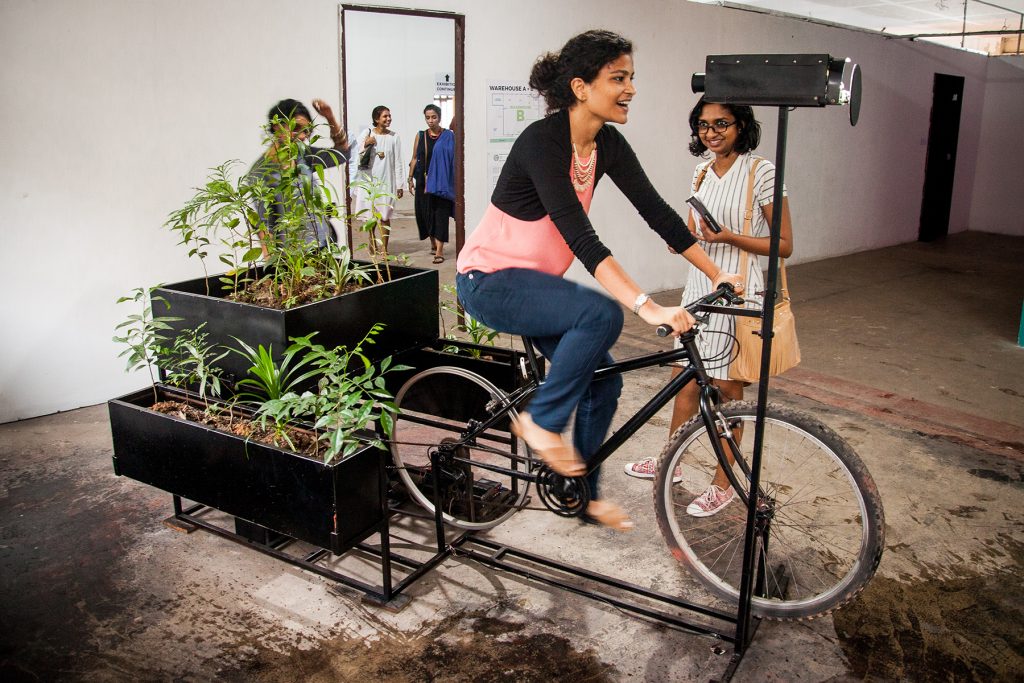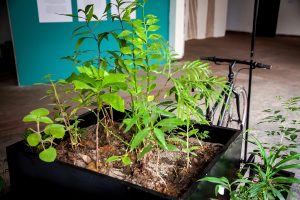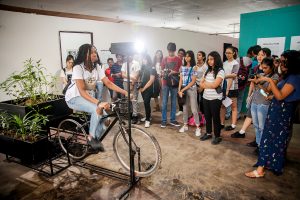RE/ CYCLEINTERRACTIVE ART INSTALLATION
The artwork is created by using entirely reclaim and donated materials collected engaging with diverse communities, the artists old artworks, organic plants and other organic forms.

The living artwork needs attentive and continuous role of participation of the audience for it to flourish. The audience is no longer an observer, the audience is responsible for the artwork as much as the artists. The Art work will not exist without the continuous RE / CYCLE process of the audience.
The main structure of the artwork is created by using the artists’ old artwork which made from a stationary bicycle. The stationary bicycle is covered with organic plants, herbal plants, fruits, vegetables, and flowering plants which create a fantasy garden space. These plants are carefully selected by the artists engaging with environmentalists, organic farmers, villagers, and traditional ayurvedic doctors over years. The organic planting methods are used to cultivate these plants. These plants unfold multiple narratives and histories connected with sociopolitical and ecological systems.
The audience can paddle the bicycle structure covered with plants. The peddling not only activates the decompose unit for plants to nourish. The energy generated by paddling is used to produce electricity to function the music. When the audience starts peddling, they will hear the soothing sounds of nature such as birds chirping and the sounds of the flowing water. These sounds are recorded by the artists at their journey collecting the exhibited plants and sounds at their own residency and studio spaces which is surrounded by lush greenery. Together, with the sounds from nature the artists will merge some selected traditional folk songs and poems sung by the ancient local villagers. These folk songs and poems mostly connected with the agriculture which represents their connectivity with the environment through various day to day activities. During the exhibition, the sounds generated through the artwork will blend with background sounds of the urban landscape. When the peddling is stopped the sounds will also end.
The kaleidoscope also will function when peddling. Inside the kaleidoscope includes small photographs of plants and organic forms used in the project. When peddling, through the kaleidoscope scope audience will see the fragmented forms of natural element which creates new harmonies, new contrasts, and new combinations of the natural world. At this point, natural world will appear in front of the audience like a fantasy. But many years back, for humankind the vision of the natural world was not a fantasy it is a reality we all lived. Nature has once been a home for all of us. Today nature has become a place to visit, a fantasy to have.
The living artwork needs attentive and continuous role of participation of the audience for it to flourish. The audience is no longer an observer; the audience is responsible for the artwork as much as the artists. The Art work will not exist without the continuous RE/ CYCLE process of the audience.
This community engaging, solution focus art work is a platform to build creative activists and more effective, sustainable, dynamic art forms and practices to address contemporary ecological issues. This goes beyond the normal biological definition of ecology as the relationships between living things. Instead, emphasis on the philosophical concept of ecological systems as Mind, Society and Environment.






